Themed collection Emergent Polyoxometalates and Soft-oxometalates

Introduction for the Emergent Polyoxometalates and Soft-oxometalates thematic issue
New advances in polyoxometalate-containing systems are presented, with emphasis on those for which non-covalent organization creates new structures with new properties.
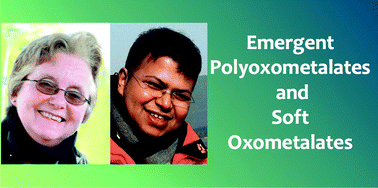
New J. Chem., 2016,40, 882-885
https://doi.org/10.1039/C6NJ90006B
Covalently-linked polyoxometalate–polymer hybrids: optimizing synthesis, appealing structures and prospective applications
In this perspective, the field of covalent polyoxometalate–polymer hybrids has been reviewed and some perspectives are provided.
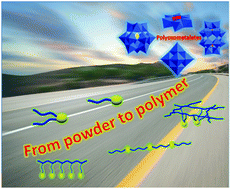
New J. Chem., 2016,40, 886-897
https://doi.org/10.1039/C5NJ01257K
Pathways for oxygen-isotope exchange in two model oxide clusters
Coupled dynamic simulation and isotope-exchange studies of polyoxometalate ions stress the importance of metastable structural states.

New J. Chem., 2016,40, 898-905
https://doi.org/10.1039/C5NJ00985E
Fourfold action of surfactants with superacid head groups: polyoxometalate–silicone nanocomposites as promising candidates for proton-conducting materials
Surfactants with a polyoxometalate (POM) [PW11O39]3− head and protons as counter-ions are used for the emulsion polymerization of hybrid polydimethylsiloxane (PDMS) networks.

New J. Chem., 2016,40, 919-922
https://doi.org/10.1039/C5NJ01544H
Polyoxometalate-assisted fabrication of the Pd nanoparticle/reduced graphene oxide nanocomposite with enhanced methanol-tolerance for the oxygen reduction reaction
The prepared Pd/polyoxometalate/reduced graphene oxide (Pd/POM/rGO) nanocomposite exhibits enhanced catalytic activity and excellent methanol-tolerance due to the synergistic effect of Pd, POM, and rGO.

New J. Chem., 2016,40, 914-918
https://doi.org/10.1039/C5NJ01659B
Nucleophilic substitution reaction for rational post-functionalization of polyoxometalates
Substitution reactions of polyoxometalate–organic hybrid materials provide a post-functionalization protocol to bring in various additional functional groups.
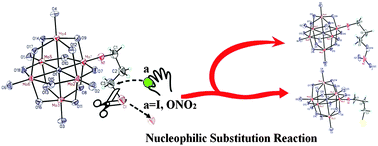
New J. Chem., 2016,40, 906-909
https://doi.org/10.1039/C5NJ01090J
Solution behaviour of a polymer with polyoxometalate inorganic molecular clusters in its main chain
A polymer containing polyoxometalates in its main chain exists as a thin rod in a good solvent. The addition of a poor solvent induces the formation of hollow cylinders through counterion mediated attraction.
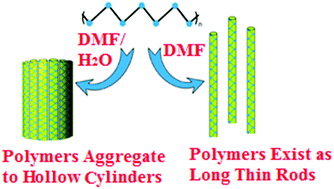
New J. Chem., 2016,40, 910-913
https://doi.org/10.1039/C5NJ01326G
In vitro cell cytotoxicity profile and morphological response to polyoxometalate-stabilised gold nanoparticles
Polyoxometalate-stabilised gold nanoparticles internalise in vast quantities into kidney epithelial and skin melanoma cell lines causing antiproliferative action on tumoural cells.
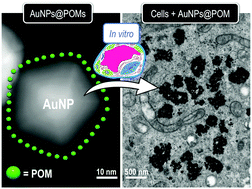
New J. Chem., 2016,40, 1039-1047
https://doi.org/10.1039/C5NJ02775F
Synthesis and characterization of metal-substituted tetraalkylphosphonium polyoxometalate ionic liquids
Trihexyl(tetradecyl)phosphonium and Keggin polyoxotungstates [PW11O39M(H2O)]n−, M = Fe, Co, Mn, or related lacunary [PW11O39]7− and [P2W20O70(H2O)2]10− anions yield compounds that are liquids at room temperature.

New J. Chem., 2016,40, 945-953
https://doi.org/10.1039/C5NJ01093D
On the formation of gold nanoparticles from [AuIIICl4]− and a non-classical reduced polyoxomolybdate as an electron source: a quantum mechanical modelling and experimental study
DFT calculations and experimental data prove that the [Na{(MoV2O4)3(μ2-O)3(μ2-SO3)3(μ6-SO3)}2]15− POM is capable of completely reducing Au(III) to Au(0).
![Graphical abstract: On the formation of gold nanoparticles from [AuIIICl4]− and a non-classical reduced polyoxomolybdate as an electron source: a quantum mechanical modelling and experimental study](/en/Image/Get?imageInfo.ImageType=GA&imageInfo.ImageIdentifier.ManuscriptID=C5NJ02773J&imageInfo.ImageIdentifier.Year=2016)
New J. Chem., 2016,40, 1029-1038
https://doi.org/10.1039/C5NJ02773J
Cesium salts of niobo-tungstate isopolyanions with intermediate group V–group VI character
The physical and electronic structures of cesium salts of niobo-tungstate Lindqvist ions vary with Nb content, elucidated experimentally and computationally.
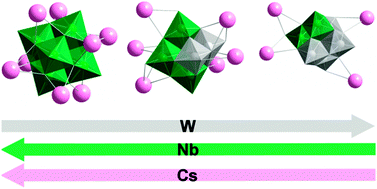
New J. Chem., 2016,40, 928-936
https://doi.org/10.1039/C5NJ02914G
New sterically encumbered arylimido hexamolybdates for organic oxidation reactions
Surface modification of the parent hexamolybdate by aryl amines results in useful catalysts for the oxidation of cyclohexene to cyclohexene epoxide and benzyl alcohol to benzaldehyde and benzoic acid.
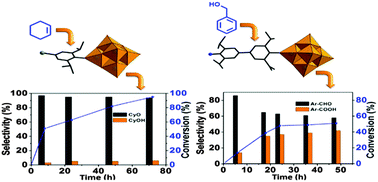
New J. Chem., 2016,40, 1004-1013
https://doi.org/10.1039/C5NJ02330K
Preparation of polyoxometalate stabilized gold nanoparticles and composite assembly with graphene oxide: enhanced electrocatalytic performance
P5W30 stabilized Au nanoparticles and graphene oxide were fabricated to form composite films exhibiting good electrocatalytic activity for H2O2 reduction.
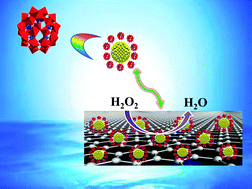
New J. Chem., 2016,40, 985-993
https://doi.org/10.1039/C5NJ01983D
Self-assembly of the polyoxometalate–cholesterol conjugate into microrods or nanoribbons regulated by thermodynamics
The self-assembly of the polyoxometalate–cholesterol conjugate can be well controlled and regulated by means of a temperature-mediated approach.
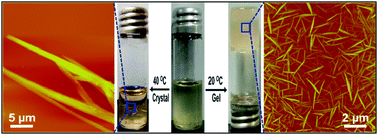
New J. Chem., 2016,40, 954-961
https://doi.org/10.1039/C5NJ02271A
Enhancement of photochemical heterogeneous water oxidation by a manganese based soft oxometalate immobilized on a graphene oxide matrix
Enhancement of photochemical water oxidation using a graphene oxide matrix for [Na17[Mn6P3W24O94(H2O)2]·43H2O@GO] soft-oxometalate is shown.
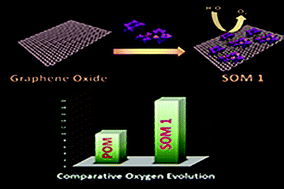
New J. Chem., 2016,40, 994-1003
https://doi.org/10.1039/C5NJ01099C
Exploring the phase explosion of water using SOM-mediated micro-bubbles
We study the growth of a homogeneously nucleated micro-bubble amidst convective flows in water superheated close to the critical point.

New J. Chem., 2016,40, 1048-1056
https://doi.org/10.1039/C5NJ01856K
Size and shape trump charge in interactions of oxovanadates with self-assembled interfaces: application of continuous shape measure analysis to the decavanadate anion
Using 51V NMR spectroscopy, dynamic light scattering and continuous shape analysis to characterize two polyoxometalate-encapsulation in reverse micelles.

New J. Chem., 2016,40, 962-975
https://doi.org/10.1039/C5NJ01788B
Autonomous movement induced in chemically powered active soft-oxometalates using dithionite as fuel
Micromotors based on Mo7 soft-oxometalates (SOMs) which are very easy to synthesize and move autonomously in the presence of dithionite which acts as the chemical fuel.

New J. Chem., 2016,40, 1057-1062
https://doi.org/10.1039/C5NJ01097G
POSS-derived mesoporous ionic copolymer–polyoxometalate catalysts with a surfactant function for epoxidation reactions
Novel mesoporous POSS-derived POM-paired polymeric hybrids were demonstrated to be highly efficient interfacial solid catalysts for the epoxidation of alkenes with H2O2.
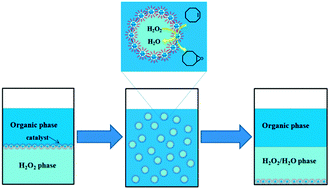
New J. Chem., 2016,40, 1022-1028
https://doi.org/10.1039/C5NJ01541C
Characterization of PtIV-containing polyoxometalates by high-resolution solid-state 195Pt and 51V NMR spectroscopy
High-resolution solid-state 195Pt MAS NMR spectroscopy is a powerful technique for the characterization of PtIV-containing polyoxometalates, as is demonstrated for several examples.
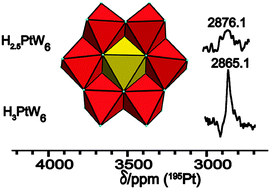
New J. Chem., 2016,40, 923-927
https://doi.org/10.1039/C5NJ01242B
Polyoxoanions assembled by the condensation of vanadate, tungstate and selenite: solution studies and crystal structures of the mixed metal derivatives (NMe4)2Na2[WVI4VV2O19]·8H2O and (NMe4)4.83[(SeIV WVI4.57VV4.43O33)2(WVI(O)(H2O))(VVO)2.6]·10.57H2O
The reaction of SeO32−/WO42−/VO43− gives a complex mixture of Lindqvist W–V anions and larger Se–W–V containing POMs.
![Graphical abstract: Polyoxoanions assembled by the condensation of vanadate, tungstate and selenite: solution studies and crystal structures of the mixed metal derivatives (NMe4)2Na2[WVI4VV2O19]·8H2O and (NMe4)4.83[(SeIV WVI4.57VV4.43O33)2(WVI(O)(H2O))(VVO)2.6]·10.57H2O](/en/Image/Get?imageInfo.ImageType=GA&imageInfo.ImageIdentifier.ManuscriptID=C5NJ00858A&imageInfo.ImageIdentifier.Year=2016)
New J. Chem., 2016,40, 937-944
https://doi.org/10.1039/C5NJ00858A
Photoredox catalysis for oxygenation/deoxygenation between sulfides and sulfoxides by visible-light-responsive polyoxometalates
We report the visible-light-responsive photoredox catalysis of a lacunary silicotungstate for selective aerobic oxygenation of sulfides and deoxygenation of sulfoxides.
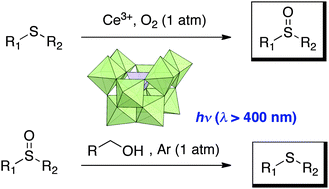
New J. Chem., 2016,40, 1014-1021
https://doi.org/10.1039/C5NJ01045D
Influence of the amino acid side chain on peptide bond hydrolysis catalyzed by a dimeric Zr(IV)-substituted Keggin type polyoxometalate
Structurally different dipeptides were hydrolyzed by [{α-PW11O39Zr-(μ-OH)(H2O)}2]8−. The rate constants were dependent on bulkiness and chemical nature of the dipeptide.
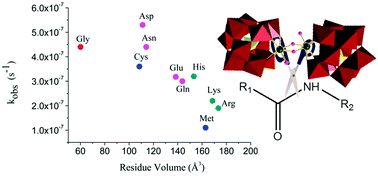
New J. Chem., 2016,40, 976-984
https://doi.org/10.1039/C5NJ00561B
About this collection
This themed collection on polyoxometalates (POMs) and soft-oxometalates (SOMs) was guest edited by Soumyajit Roy and Debbie Crans. The issue contains two Perspective review articles; the first describes polymer–POM hybrid materials and is written by Wei Wang and co-authors. The second from William Casey and James Rustad reviews isotopic exchange in metal oxide clusters as relevant to geochemistry. The collection is completed by 20 original research contributions covering the conception and characterisation of POMs and SOMs, their properties and applications in a variety of fields such as catalysis, biology, and active matter.